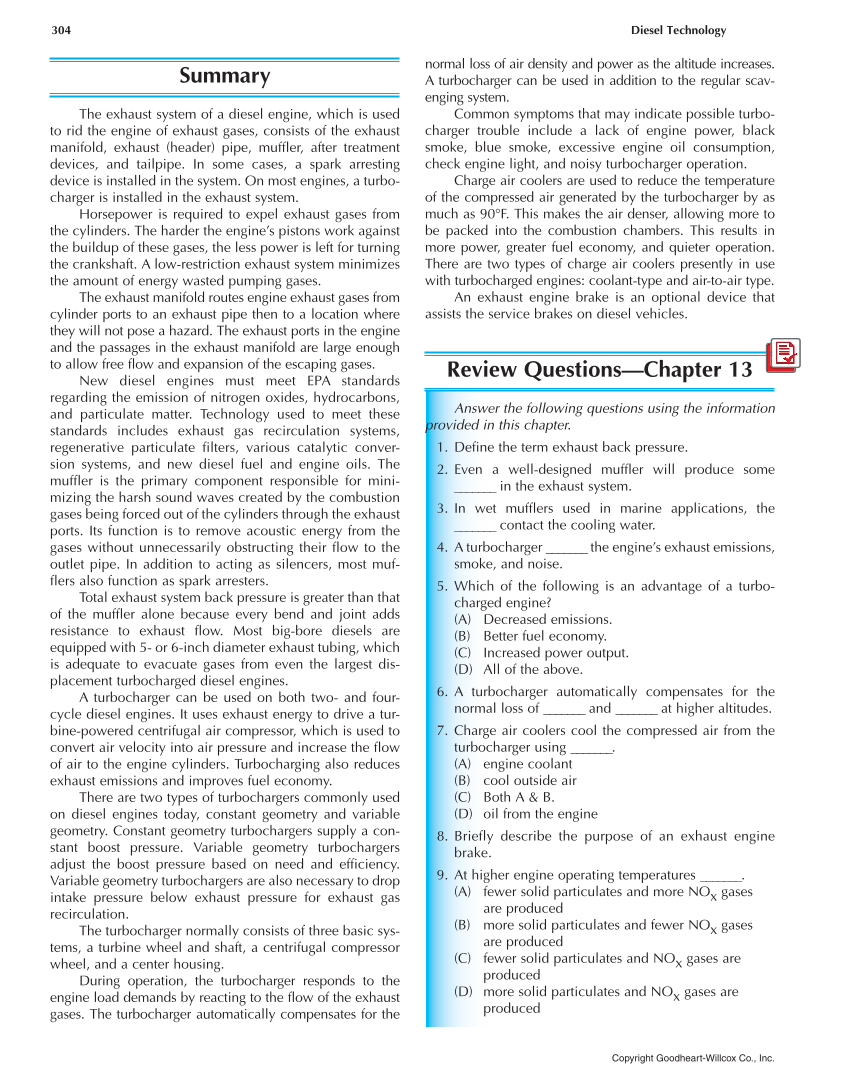304 Diesel Technology Copyright Goodheart-Willcox Co., Inc. Summary The exhaust system of a diesel engine, which is used to rid the engine of exhaust gases, consists of the exhaust manifold, exhaust (header) pipe, muffler, after treatment devices, and tailpipe. In some cases, a spark arresting device is installed in the system. On most engines, a turbo- charger is installed in the exhaust system. Horsepower is required to expel exhaust gases from the cylinders. The harder the engine’s pistons work against the buildup of these gases, the less power is left for turning the crankshaft. A low-restriction exhaust system minimizes the amount of energy wasted pumping gases. The exhaust manifold routes engine exhaust gases from cylinder ports to an exhaust pipe then to a location where they will not pose a hazard. The exhaust ports in the engine and the passages in the exhaust manifold are large enough to allow free flow and expansion of the escaping gases. New diesel engines must meet EPA standards regarding the emission of nitrogen oxides, hydrocarbons, and particulate matter. Technology used to meet these standards includes exhaust gas recirculation systems, regenerative particulate filters, various catalytic conver- sion systems, and new diesel fuel and engine oils. The muffler is the primary component responsible for mini- mizing the harsh sound waves created by the combustion gases being forced out of the cylinders through the exhaust ports. Its function is to remove acoustic energy from the gases without unnecessarily obstructing their flow to the outlet pipe. In addition to acting as silencers, most muf- flers also function as spark arresters. Total exhaust system back pressure is greater than that of the muffler alone because every bend and joint adds resistance to exhaust flow. Most big-bore diesels are equipped with 5- or 6-inch diameter exhaust tubing, which is adequate to evacuate gases from even the largest dis- placement turbocharged diesel engines. A turbocharger can be used on both two- and four- cycle diesel engines. It uses exhaust energy to drive a tur- bine-powered centrifugal air compressor, which is used to convert air velocity into air pressure and increase the flow of air to the engine cylinders. Turbocharging also reduces exhaust emissions and improves fuel economy. There are two types of turbochargers commonly used on diesel engines today, constant geometry and variable geometry. Constant geometry turbochargers supply a con- stant boost pressure. Variable geometry turbochargers adjust the boost pressure based on need and efficiency. Variable geometry turbochargers are also necessary to drop intake pressure below exhaust pressure for exhaust gas recirculation. The turbocharger normally consists of three basic sys- tems, a turbine wheel and shaft, a centrifugal compressor wheel, and a center housing. During operation, the turbocharger responds to the engine load demands by reacting to the flow of the exhaust gases. The turbocharger automatically compensates for the normal loss of air density and power as the altitude increases. A turbocharger can be used in addition to the regular scav- enging system. Common symptoms that may indicate possible turbo- charger trouble include a lack of engine power, black smoke, blue smoke, excessive engine oil consumption, check engine light, and noisy turbocharger operation. Charge air coolers are used to reduce the temperature of the compressed air generated by the turbocharger by as much as 90°F. This makes the air denser, allowing more to be packed into the combustion chambers. This results in more power, greater fuel economy, and quieter operation. There are two types of charge air coolers presently in use with turbocharged engines: coolant-type and air-to-air type. An exhaust engine brake is an optional device that assists the service brakes on diesel vehicles. Review Questions—Chapter 13 Answer the following questions using the information provided in this chapter. 1. Define the term exhaust back pressure. 2. Even a well-designed muffler will produce some _______ in the exhaust system. 3. In wet mufflers used in marine applications, the _______ contact the cooling water. 4. A turbocharger _______ the engine’s exhaust emissions, smoke, and noise. 5. Which of the following is an advantage of a turbo- charged engine? (A) Decreased emissions. (B) Better fuel economy. (C) Increased power output. (D) All of the above. 6. A turbocharger automatically compensates for the normal loss of _______ and _______ at higher altitudes. 7. Charge air coolers cool the compressed air from the turbocharger using _______. (A) engine coolant (B) cool outside air (C) Both A & B. (D) oil from the engine 8. Briefly describe the purpose of an exhaust engine brake. 9. At higher engine operating temperatures _______. (A) fewer solid particulates and more NOx gases are produced (B) more solid particulates and fewer NOx gases are produced (C) fewer solid particulates and NOx gases are produced (D) more solid particulates and NOx gases are produced
